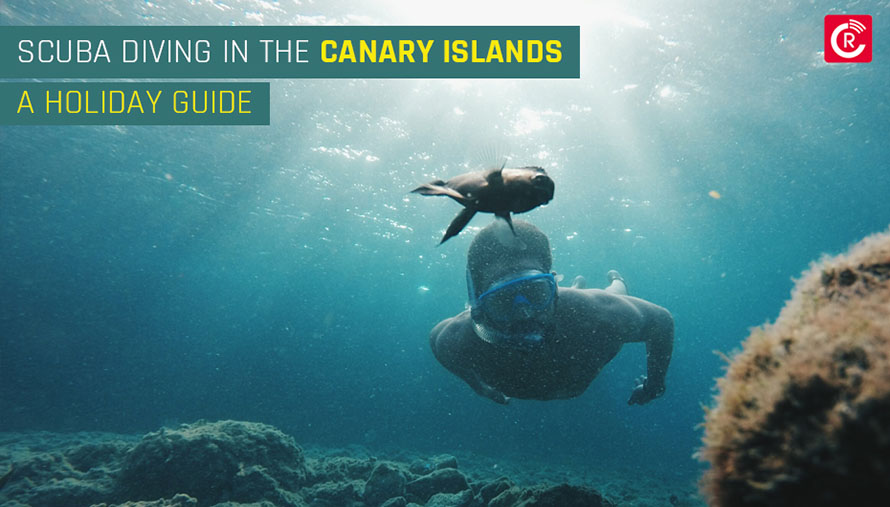
Located in the North Atlantic oceans to the west of Morocco, the Canary Islands are more than just a group of islands also called an Archipelago; it is a complete experience.
Though a part of Spain, the Archipelago has its own set of laws and consists of seven main islands, six smaller islands, and a few islets, covering a vast area.
The islands result from volcanic eruptions; however, all the islands are quite different with something unique to offer despite the similar origin. Needless to say, the perfect travel destination they make for, given the legends and myths shrouding the canary islands, which make their appeal even intense.
If the stunning rock formations, the fascinating golden beaches, or the days full of wholesome sunshine are not enough to persuade you into taking a trip to these beautiful islands, below are some other reasons that support their increasing popularity as a ‘go-to destination’ for travelers and divers worldwide.
Reasons To Go Scuba Diving In The Canary Islands
- The blend of breathtaking underwater features from the Caribbean, Africa, Hawaii, and the Red Sea is too good to miss, so much so that the locals amiably call them the ‘seven roses of the Atlantic.’
- The canary islands boast a warm subtropical climate, with the water temperatures in most seasons being 20 degrees which could fluctuate from 16-26 degrees in summers. It is also widely spoken of as an eternal spring by the locals, given the pleasant water temperatures and climatic conditions year-round.
- Thanks to the volcanic origin they share, the islands’ topography is nothing less than breathtaking, with caves, colorful volcanic reefs, wrecks, caverns, arches.
- The endless underwater exploration with over 700 marine species, from angel sharks to rare mantas, rays, morays, turtles, and cephalopods, is hard to come across.
- Water with crystal clear views with visibility that often reaches 30 plus meters.
Over 100 dive centers that organize daily excursions to a plethora of dive sites year-round make it a perfect traveler’s destination, no matter how little experience one has with scuba diving.
The Best Diving Sites Of The Canary Islands
The seven predominant islands, namely La Palma, La Gomera, Gran Canaria, Fuerteventura, Tenerife, Lanzarote, and El Hierro, though, give one several options to choose from as per their interest to explore and otherwise, also makes it quite difficult to pick a destination, especially when everything seems inviting.
But, if you are solely looking to pick the best diving spot for a fantastic scuba diving experience, look no further; the following article will discuss the best diving spots on the canary islands, their appealing features, and more –
Tenerife
Tenerife is not just the biggest or the most populated of the canary islands; it is also of great significance for a number of reasons, being home to the highest mountain – Mount Teide in Spain being one of them. The mountain rises 3718 km into the sky and has a beauty visible up to long distances.
But what about the scuba diving part?
The coastline is extended to 269 km with hundreds of dive sites, perfect for anyone looking for a less scheduled vacation or a more tourist-friendly experience on the islands.
Las Chuchos –
Las Chuchos translating to ‘rays’ in English, which justifies the name it has been given, ‘The City of Stingrays,’ is one of Tenerife’s most popular diving sites.
Though the diving centers can be accessed by amateur and advanced divers alike, the site is particularly deeper, making it a better option for someone experienced.
With a maximum depth of 22 meters and an average depth of 16 meters, the site is packed with little caverns, overhangs, and also a sunken fisherman’s wooden boat. Though there is plenty of diverse marine life, the most common sightings on the site are that of stingrays and morays eels.
A two-minute boat trip outside the port of Las Galletas, a beautiful seaside town one would love to visit, will get you to your diving site Las Chuchos.
Grand Canaria
Grand Canaria is the third largest of the canary islands but contains almost half of the total population, and there is little surprise as to why, given the white sandy beaches that extend across the coastline, prevalent duty-free shopping, beautiful mountain landscapes, and much more.
Apart from scuba diving, one could take part in a number of other fun activities that include cycling around the pretty infrastructure and hiking.
Lets’s look at a popular diving site on the island – El Cabron.
El Cabron –
Located in the subtropical water of the Grand Canaria is a world-famous Marine Reserve known as El Cabron, which is also one of the three marine reserves on the canary islands.
The site has been listed among the top ten diving sites in Europe, thanks to the rugged and rocky terrain alongside the underwater volcanic landscape and year-round average water temperature of 20 degrees.
The diversity and density of marine life on the site are astonishing, resulting from a mixture of species from the Atlantic, Mediterranean, Caribbean, and abundant Seagrass beds. One can certainly spot a variety of marine life while scuba diving, from angel sharks to butterflyfish, nudibranchs, and red parrotfish.
What’s more, the title of Marnie reserve helps preserve marine life even more efficiently as it prohibits boating, fishing, including invasive activities like mining.
Lanzarote
Located seventy miles off the coast of Africa, Lanzarote is not just the fourth largest of the Archipelago but also the youngest. The stunning volcanic rock formations, great weather, and crystal clear waters, green and semi-desert landscapes make it a great vacation spot with phenomenal visuals and countless adventures.
Let’s see one of the most prestigious and appealing diving spots in Lanzarote – the underwater museum.
The Underwater Museum –
Created to promote education and protect the natural environment is the underwater museum of sculptures located in Lanzarote, the only one in entire Europe.
It serves a visually remarkable diving experience and promotes sustainability through sculptures made with 100% environmentally friendly resources. These total of 300 life-size human figures were created by Jason deCaires Taylor, which extends over 2,500 square meters.
The depth of only 12 meters further makes it an ideal spot to explore for both beginners and experienced divers.
El Hierro
Being the smallest one of the canary islands does not mean El Hierro has anything less to offer; instead, it is among one of the best and recommended diving spots throughout.
El Hierro is remote and wild and lays farthest south of the canary islands, making it a slow-paced and serene diving spot. The beautiful volcanic terrain and cliff-lined shores of the island, alongside the fact that it soon plans to become the first energy-sufficient island in the world with solar, sun, and wind power, further intensifies tourist attraction.
A famous diving spot in El Hierro is El Bajon. Let’s discuss its details and the features that make it so popular –
El Bajon –
Abundant marine life can be witnessed in the underwater world of this dive site of El Hierro, which is located at the southernmost tip of the El Hierro just by La Restinga(a fishing town), so much so that locals say that any and every species of the island can be seen in this one diving site alone.
However, the vertical cliff that drops down to 100 meters of crystal clear blue depth, apart from the diverse marine life, is often called out as a prime reason for the popularity of El Banjo.
The opportunity to spot rare species of dolphins, sharks, and devil manta rays alone is enough to attract world-class divers to the spot.
What’s more, the volcanic activity that has resulted in rock formation has forged marvelous tunnels, caves, and arches and will require you to carry a torch for exploring the crevasses as the spots within are often frequented by octopuses, lobsters, and moral eels.
With excellent year-round visibility that barely drops below thirty meters make it a perfect diving spot no matter which season or what time of the year it is.
Other spots worth exploring in the Canary islands –
Masca Bay –
A small village on the island of Tenerife is Masca, which at Masca bay(30 minutes north by boat) offers the opportunity for experienced divers to get a rare look at black corals.
La Gomera –
Famous for its breathtaking volcanic landscape is the 12-mile wide tiny island of La Gomera, a place with practically no mass tourism. Apart from abundant marine life and rock formations, a popular boat dive known as Cascante make the island even more interesting and fun.
Conclusion
Though the canary islands might not be as tropic or with more diverse marine life as one expects to witness in the Red Sea, the fact that brilliant weather and excellent water visibility with astonishing volcanic rock formations and landscapes of the Canary Islands are hard to compete as well cannot be emphasized enough.
The measure of popularity is evident from the number of tourists who visit the islands every year, making it a must-not-be-missed scuba diving locales. Happy Scrolling!





